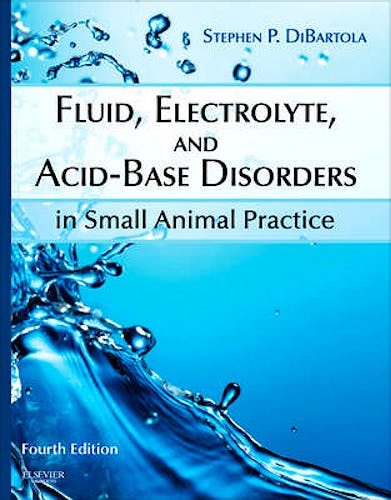

No hay productos en el carrito



Fluid, Electrolyte, and Acid-Base Disorders in Small Animal Practice
DiBartola, S.
4ª Edición Julio 2011
Inglés
Tapa dura
1520 pags
2264 gr
22 x 28 x 4 cm
ISBN 9781437706543
Editorial Saunders (W.B.) Co Ltd
LIBRO IMPRESO
-5%
118,80 €112,86 €IVA incluido
114,23 €108,52 €IVA no incluido
Recíbelo en un plazo de
7 - 10 días
LIBRO ELECTRÓNICO
-5%
119,59 €113,61 €IVA incluido
114,99 €109,24 €IVA no incluido
Acceso On Line
Inmediato
DESCRIPTION
The leading reference for the diagnosis and management of fluid, electrolyte, and acid-base imbalances in small animals, Fluid, Electrolyte, and Acid-Base Disorders in Small Animal Practice, 4th Edition provides cutting-edge, evidence-based guidelines to enhance your care of dogs and cats. Information is easy to find and easy to use, with comprehensive coverage including fluid and electrolyte physiology and pathophysiology and their clinical applications, as well as the newest advances in fluid therapy and a discussion of a new class of drugs called vaptans. Lead author Stephen DiBartola is a well-known speaker and the "go-to" expert in this field, and his team of contributors represents the most authoritative and respected clinicians and academicians in veterinary medicine.
KEY FEATURES
- Over 30 expert contributors represent the "cream of the crop" in small animal medicine, ensuring that this edition provides the most authoritative and evidence-based guidelines.
- Scientific, evidence-based insights and advances integrate basic physiological principles into practice, covering patient evaluation, differential diagnosis, normal and abnormal clinical features and laboratory test results, approaches to therapy, technical aspects of therapy, patient monitoring, assessing risk, and prediction of outcomes for each disorder.
- Hundreds of tables, algorithms, and schematic drawings demonstrate the best approaches to diagnosis and treatment, highlighting the most important points in an easy-access format.
- Drug and dosage recommendations are included with treatment approaches in the Electrolyte Disorders section.
- Clear formulas in the Fluid Therapy section make it easier to determine the state of dehydration, fluid choice, and administration rate and volume in both healthy and diseased patients.
NEW TO THIS EDITION
- Updated chapters cover the latest advances in fluid therapy in patient management, helping you understand and manage a wide range of potentially life-threatening metabolic disturbances.
- Expanded Disorders of Sodium and Water chapter includes information on a new class of drugs called vaptans, vasopressin receptor antagonists that may soon improve the ability to manage patients with chronic hyponatremia.
- Hundreds of new references cover the most up-to-date advances in fluid therapy, including renal failure and shock syndromes.
TABLE OF CONTENTS
- Section I: Applied Physiology
- 1. Applied Physiology of Body Fluids in Dogs and Cats
- 2. Applied Renal Physiology
- Section II: Electrolyte Disorders
- 3. Disorders of Sodium and Water: Hypernatremia and Hyponatremia
- 4. Disorders of Chloride: Hyperchloremia and Hypochloremia
- 5. Disorders of Potassium: Hypokalemia and Hyperkalemia
- 6. Disorders of Calcium: Hypercalcemia and Hypocalcemia
- 7. Disorders of Phosphorus: Hypophosphatemia and Hyperphosphatemia
- 8. Disorders of Magnesium: Magnesium Deficit and Excess
- Section III: Acid-Base Disorders
- 9. Introduction to Acid-Base Disorders
- 10. Metabolic Acid-Base Disorders
- 11. Respiratory Acid-Base Disorders
- 12. Mixed Acid-Base Disorders
- 13. Strong Ion Approach to Acid-Base Disorders
- Section IV: Fluid Therapy
- 14. Introduction to Fluid Therapy
- 15. Technical Aspects of Fluid Therapy
- 16. Monitoring Fluid Therapy and Complications of Fluid Therapy
- 17. Perioperative Management of Fluid Therapy
- 18. Fluid and Electrolyte Disturbances in Gastrointestinal and Pancreatic Disease
- 19. Fluid, Electrolyte, and Acid-Base Disturbances in Liver Disease
- 20. Fluid Therapy in Endocrine and Metabolic Disorders
- 21. Fluid and Diuretic Therapy in Heart Failure
- 22. Managing Fluid and Electrolyte Disorders in Renal Failure
- 23. Shock Syndromes
- Section V: Special Therapy
- 24. Blood Transfusion and Blood Substitutes
- 25. Parenteral Nutrition
- 26. Enteral Nutrition
- 27. Fluid Therapy with Macromolecular Plasma Volume Expanders
- 28. Peritoneal Dialysis
- 29. Hemodialysis
AUTHOR
By Stephen P. DiBartola, DVM, DACVIM, Professor of Medicine, Associate Dean for Administration and Curriculum, Department of Veterinary Clinical Sciences and Veterinary Administration, College of Veterinary Medicine, The Ohio State University, Columbus, OH
© 2025 Axón Librería S.L.
2.149.0